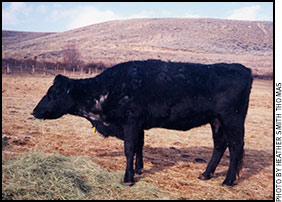Late-winter Lice Control
If cattle start to rub in January-February with more cold weather ahead, consider some additional lice control.
There are two types of cattle lice — chewing lice and sucking lice, explains Joe Campbell, a cattle professional services veterinarian with Boehringer Ingelheim Vetmedica Inc. (BIVI). “Both species reproduce more rapidly on the animal during cold weather.
 “When treating for lice, it’s important to treat as late as possible in the fall. The objective is to drive the population down before cold weather, so there won’t be a big increase in numbers before spring. If we treat too early, lice numbers build up again, and we’ll have to treat again,” he explains.
“When treating for lice, it’s important to treat as late as possible in the fall. The objective is to drive the population down before cold weather, so there won’t be a big increase in numbers before spring. If we treat too early, lice numbers build up again, and we’ll have to treat again,” he explains.
“Most of the products for lice control are very effective, but none of them kill 100% of the lice on all the cattle. There may be a low population left, and those will start to reproduce again,” he warns. There are also a few animals that seem more susceptible to lice, for whatever reason, and serve as carriers to spread lice to herdmates.
Campbell recommends using a pour-on type of product because it will control both sucking and chewing lice. Injectable endectocides, which kill internal and external parasites, only kill sucking lice that feed on blood. They don’t affect the chewing lice.
Large numbers of sucking lice affect cost of production because they can retard growth and hinder the health of the animal.
“Chewing lice are more responsible for a lot of the problems we see, however, because the cattle are rubbing on everything, and losing hair,” Campbell says. “This is hard on facilities. Cattle may knock down fences with their constant rubbing.”
If cattle start rubbing again in late winter, they may or may not need retreatment, depending on the severity of the renewed lice population, and how late in the winter you see signs of lice.
“If it’s still early, such as February/early March and there is still a lot of cold weather ahead, it will pay to retreat them,” Campbell explains. If it’s late March or early April and the days are getting longer and warmer, the lice population will soon diminish on its own.
In winter, nearly any pour-on product will be adequate to knock the lice down for the rest of the winter. Products containing synthetic pyrethroids are very effective for lice control. Sometimes you have to do something a little different because of a bad year, or in a situation where fenceline contact allowed untreated cattle to mingle with treated cattle.

Editor’s Note: Heather Smith Thomas is a freelancer and cattlewoman from Salmon, Idaho.





